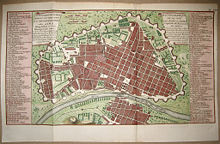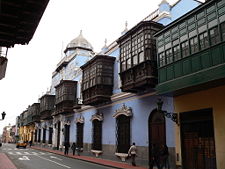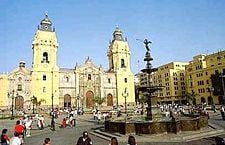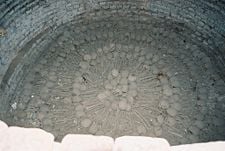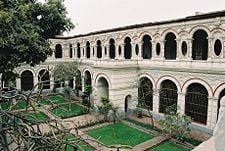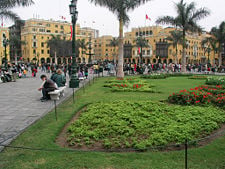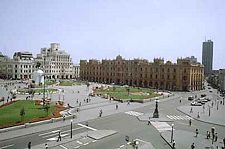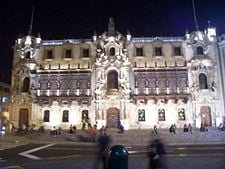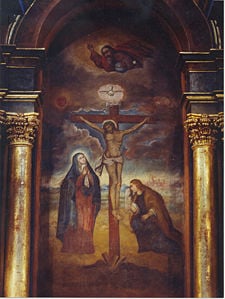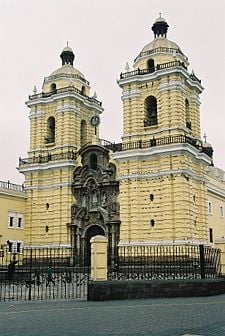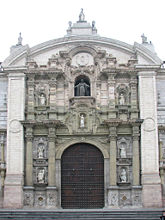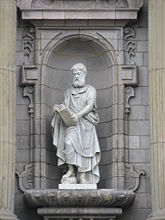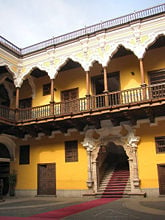Historic Center of Lima
Mary Anglin (talk | contribs) |
|||
| (44 intermediate revisions by 4 users not shown) | |||
| Line 1: | Line 1: | ||
| − | {{Images OK}} | + | {{Images OK}}{{Submitted}}{{Approved}}{{copyedited}} |
| + | {{epname|Historic Center of Lima}} | ||
{{Infobox World Heritage Site | {{Infobox World Heritage Site | ||
| WHS = Historic Centre of Lima | | WHS = Historic Centre of Lima | ||
| − | | Image = [[Image: | + | | Image =[[Image:Square in Lima Peru 01.jpg|260px|Plaza Mayor of Lima, core of the city]] |
| State Party = {{PER}} | | State Party = {{PER}} | ||
| Type = Cultural | | Type = Cultural | ||
| Line 13: | Line 14: | ||
| Link = http://whc.unesco.org/en/list/500 | | Link = http://whc.unesco.org/en/list/500 | ||
}} | }} | ||
| + | The '''Historic Centre of Lima''' is the portion of the city of [[Lima]], [[Peru]], founded in 1535 by [[Spain|Spanish]] [[conquistador]] [[Francisco Pizarro]] as ''La Ciudad de los Reyes,'' or "The City of Kings." | ||
| − | + | Lima was designated the administrative capital and most important city in the Spanish [[Viceroyalty of Peru]], established by [[Charles V]] in 1542. This viceroyalty became the richest and most powerful Spanish viceroyalty of [[The Americas]], holding jurisdiction over all of the Spanish colonies in [[South America]]. By the time of the wars of independence (1820-1824), Lima had become one of the most distinguished and aristocratic colonial capitals and the chief Spanish stronghold in the Americas. | |
| + | Today's South American [[culture]] reflects the complexity of the continent's history through the blending of pre-Hispanic [[civilization]]s and the culture of [[Spain]], imparted during that country's centuries-long colonization of the New World. [[Language]], [[music]], and [[cuisine]] are intricate mixes of indigenous and Spanish elements. The [[Catholic]] religion brought by the missionaries is the dominant [[religion]] throughout the continent. | ||
| + | {{toc}} | ||
| + | The Spanish settlement of Lima thus played a significant role in the shaping of modern-day [[Peru]] as well as much of [[South America]]. As such, the remaining buildings are historical treasures. Numerous of these buildings are the result of collaboration between [[Indigenous peoples of the Americas|Native]] and [[Europe|Old World]] craftsmen. Lima's historic center was declared a [[UNESCO]] [[World Heritage Site]] in 1988, for its originality and high concentration of historic monuments constructed in the time of Spanish presence. It is one of the most important tourist destinations in the region. | ||
| − | + | ==Foundation== | |
| + | [[Image:Lima1750.jpg|220px|thumb|left|Map of Historic Centre of Lima in 1750]] | ||
| + | The city of [[Lima]], the capital of [[Peru]], was founded by [[Francisco Pizarro]] on January 18, 1535 and given the name "City of the Kings." Nevertheless, with time its original name persisted, which may come from one of two sources: Either the Aymara language ''lima-limaq'' (meaning "yellow flower"), or the Spanish pronunciation of the [[Quechuan languages|Quechuan]] word ''rimaq'' (meaning "talker," and actually written and pronounced ''limaq'' in the nearby [[Quechua#Geographic distribution|Quechua I]] languages). It is worth noting that the same Quechuan word is also the source of the name given to the river that feeds the city, the [[Rímac|Rimac river]] (pronounced as in the politically dominant Quechua II languages, with an "r" instead of an "l"). Early maps of Peru show the two names displayed jointly. | ||
| + | The period of [[colonialism]] in [[South America]] was a time of magnificence and grandeur. Buildings were created as works of art. | ||
| + | A disastrous [[earthquake]] in 1656 destroyed many of the original structures in Lima. Reconstruction was begun the following year, much of it undertaken by Portuguese architect Constantino de Vasconsellos. His protégé, Lima-born Manuel de Escobar, later succeeded him in the task. | ||
| + | ==Balconies of Lima== | ||
| + | {| | ||
| + | [[Image:Casa de Osambela.JPG|225px|right|thumb|A variety of balconies adorn the Old City of Lima, one of its trademarks.]] | ||
| + | [[Image:Lima_Cathedral.jpg|225px|thumb|Basilica Cathedral]] | ||
| + | [[Image:Francisco Pizarro Tumba.JPG|thumb|225px|[[Francisco Pizarro]]'s tomb in the Basilica Cathedral]] | ||
| + | [[Image:Lima Convento San Fransisco Catacombs.jpg|thumb|225px|Catacombs filled with skulls and bones, neatly organized to form geometric figures, beneath the Church of San Francisco.]] | ||
| + | [[Image:Lima Convento San Fransisco Courtyard.jpg|thumb|225px|Courtyard with cloisters at the Church of San Francisco.]] | ||
| + | [[Image:Lima_Plaza_Mayor1.jpg|225px|thumb|right|Main Square.]] | ||
| + | [[Image:San Martín Plaza.jpg|225px|thumb|right|San Martín Square.]] | ||
| + | [[Image:Lima's Archbishop Palace.jpg|thumb|225px|The Archbishop's Palace illuminated at night.]] | ||
| + | [[Image:SeñordelosMilagrosNazarenas.jpg|thumbnail|225px|right|Mural Señor de los Milagros in the Santuary of Las Nazarenas.]] | ||
| + | [[Image:Lima Convento San Fransisco.jpg|thumb|225px|Plaza in front of the Church of San Francisco.]] | ||
| + | |} | ||
| + | Lima is well-known for its balconies—more than 1,600—that were built in the [[Viceroyalty of Peru|viceroyalty]] era as well as during the republic. The abundance of these balconies adds to the particular harmony and originality in this part of the city. | ||
| + | The Municipality of Lima has adopted a system of "balcony adoption," giving both individuals and companies the opportunity to personally maintain an historic piece of the city. | ||
| + | ==Principal monuments== | ||
| + | ;Plaza Mayor | ||
| + | The Plaza Mayor (Plaza de Armas of Lima) is the birthplace of the city of [[Lima]], as well as the core of the city. Located in the Historic Centre of Lima, it is surrounded by the Government Palace, Cathedral of Lima, Archbishop's Palace of Lima, the Municipal Palace, and the Club of the Union. | ||
| − | + | In 1523, King [[Charles I of Spain]] mandated the ''Procedures for the creation of cities in the New World''. These procedures indicated that after outlining a city's plan, growth should follow a grid centered on the square shape of the plaza. | |
| + | |||
| + | On the day of the foundation of the city, January 18, 1535, the [[conquistador]] [[Francisco Pizarro]], conforming to established procedure, designated a location to build the plaza. Later, Pizarro and [[Nicolas de Rivera]], the city's first mayor, toured the city's location and split parcels. Pizarro took for his residence a large parcel of land between the north side of the plaza and the [[Rimac river]]. The lot to the south of the plaza was designated to be a church, the western lot was to be the site of a city council, and the remaining lots were divided among the rest of the conquistadors. | ||
| + | |||
| + | The seventeenth century historian [[Bernabé Cobo]] said of the plaza: | ||
| + | |||
| + | <blockquote>…it is the finest and most well-formed [plaza] that I have ever seen, even in Spain. It occupies an entire block, with the width of four streets on one side and four streets on the other, and with all four sides it measures more than two thousand feet; it is very flat…</blockquote> | ||
| + | |||
| + | The first water fountain built on the plaza was constructed by the [[Viceroys of Peru|viceroy]] [[Francisco de Toledo]], and was inaugurated on October 21, 1578. It consisted of a [[baluster]] and an elevated bowl, and contained eight pipes through which water fell into the bowl on the next level. A ball at the top of the fountain dispersed water back onto the lower levels. The seal of the city was inscribed on this ball. | ||
| + | |||
| + | This fountain was replaced by the [[Viceroys of Peru|viceroy]] [[García Sarmiento de Sotomayor]], count of [[Salvatierra]], who inaugurated the new one on September 8, 1651. This fountain remains as the centerpiece of the plaza. | ||
| + | |||
| + | During the colonial era, the plaza served as a market, bullfighting ring, and the city gallows. The plaza also became home to the [[Auto de fe]] in which the [[inquisition]] occurred. The tribunal of the inquisition had one of its three courts located in [[Lima]]. The first conviction occurred on November 15, 1573; the first so-called heretic to be tried and executed in the New World. In 1821, [[José de San Martín]] proclaimed the [[Peruvian War of Independence|Independence of Peru]] on this plaza, after which the flag of the new republic was paraded around the plaza. The Plaza Mayor continues to be used for all historic events. | ||
| + | |||
| + | ;Archbishop's Palace | ||
| + | The Archbishop's Palace is a structure that was opened in 1924, and is considered a prime example of neo-colonial [[architecture]] that flourished in Lima during the early twentieth century. It is located on land originally allocated by Pizarro as the residence of the head priest of Lima. The first church on this site began construction in 1535. [[Pope Paul III]] named Lima an episcopal seat in 1541 and designated the palace as the primary church headquarters of the city. In 1547, Lima was elevated to an archdiocese and the building served as its headquarters. | ||
| + | |||
| + | The palace was designed by the Polish-Peruvian architect Ricardo de Jaxa Malachowski, who used the [[Torre Tagle Palace]] as a reference point. The facade is composed of [[baroque]] elements, completely constructed of reintegrated rock; ornate [[cedar]] balconies are located over the main doors, and the palace is finished by a [[granite]] sculpture of [[Saint Turibius of Mongrovejo]], the patron protector of the Archdiocese. The palace has two flagpoles, one for the [[Flag of Peru|Peruvian flag]] and another for the flag of the [[Vatican]]. | ||
| + | |||
| + | The interior, which hosts a sculpture of [[Saint Barbara|Santa Barbara]], one of the Catholic Church's [[Fourteen Holy Helpers]], is completely ornate. The ceiling contains famous French [[stained glass]] windows, illuminating the church during the daylight hours. [[Marble]] staircases with wooden handrails allow access to the second story. The palace now serves as headquarters to the offices of the [[Cardinal (Catholicism)|cardinal]] of Peru and archbishop of Lima. | ||
| + | |||
| + | ;Basilica Cathedral | ||
| + | The construction of the Basilica Cathedral of Lima, a well-known symbol of the city, began at the city's founding in 1535. Due to the [[earthquake]]s that frequently devastated the city, it has been transformed many times, but it still retains its [[Colonialism|colonial]] composition and facade. It is located beside the Archbishop's Palace. | ||
| + | |||
| + | The construction on the original building was completed in 1538. It was described as primitive, small and rustic. In 1541, the church was designated a cathedral. Additional structures were built and the building upgraded over the next several years. Throughout the remainder of the century the cathedral was redesigned and rebuilt on its original foundations, in an attempt to make it more closely resemble the [[Cathedral of Seville]] in [[Spain]]. In the following centuries, parts of the Cathedral were damaged or destroyed by earthquakes four times; the building was renovated after each occurrence. | ||
| + | |||
| + | The cathedral has three doors on its front facade, 14 side doors, and two back doors. Each is ornate and is named after a saint. | ||
| + | |||
| + | Along the interior walls are the [[Stations of the Cross]] ''(Via Crucis)''. The chapels are adorned with sculptures and images of numerous saints. The chapel ''Capilla de la Sagrada Familia'' (chapel of the [[Holy Family]]), features figures of [[Jesus]], [[Mary (mother of Jesus)|Mary]], and [[Saint Joseph|Joseph]]. | ||
| − | The | + | ;Government Palace |
| + | The Government Palace, also known as the House of Pizarro, is the residence of the President of Peru. | ||
| − | + | Pizarro built a modest two story dwelling for himself upon his arrival in Lima. The grounds were large to accommodate troops and horse stables. Upon Pizarro's death, Spanish viceroys took over the building, converted it into a Viceregal Palace and continually enlarged the building over time. | |
| + | |||
| + | It served as the residence of viceroys until they were forced out in 1821. Since that time it has served as the headquarters of the Presidents of the Republic of Peru. In 1921, fire destroyed a great deal of the building. Reconstruction was completed in 1938. | ||
| − | + | There is a well-kept garden on the grounds and a number of courtyards, halls and rooms dedicated to notable figures of Peruvian history. | |
| − | |||
| − | |||
| − | |||
| − | + | ;Torre Tagle Palace | |
| − | + | The Torre Tagle Palace is a [[Spanish Baroque]] palace that serves as home to the Peruvian Ministry of Foreign Affairs. | |
| − | The | + | The palace was commissioned in 1715 (some say 1730) by Don [[José Tagle and Brachio]] (Marquis Torre Tagle), who at the time was treasurer of the [[Royal Spanish fleet]], for his own personal use as his home. |
| − | The | + | The exterior of the palace has a [[baroque]] stone doorway. The main facade is made from [[stone]] in the first wing and plaster in the second. The style is [[Sevillian]] baroque with a strong [[Mudejar]] influence. The materials used in its construction were brought from [[Spain]], [[Panama]], and [[Central America]]. |
| − | + | Apart from carved columns, the palace is distinguished by two finely worked balconies in dark wood. These balconies adapt the European architecture to vernacular Peruvian tradition. The interiors feature Sevillian tiles, plasterwork, wooden columns, lobed Moorish arches and soaring [[coffered ceiling]]s. It is considered to have a true "Limeño" architectural originality, harmoniously combining [[Andalusia]]n, [[Moorish]], ''[[Creole peoples|Criollo]],'' and [[Asia|Asian]] features. | |
| − | |||
| − | |||
| − | |||
| − | The | ||
| − | |||
| − | + | ;Basilica of Our Lady of the Rosary and Convent of Santo Domingo | |
| − | + | Construction of the church and convent began at the founding of Lima and was not completed until the end of the sixteenth century. It is composed of three naves with a carved choral ashlar masonry in [[cedar]] wood. The church is crowned by a large cupola. The interior displays images from the first years of the City and also an image of [[Our Lady the Virgin of the Rosary]]. | |
| − | |||
| − | |||
| − | |||
| − | |||
| − | + | The convent has Sevillian style patios in tile, with [[baroque]] style in the interior. It was here, in 1551, that the [[National University of San Marcos]] was founded, the first in the Americas. | |
| − | [[ | ||
| − | |||
| − | + | The temple of ''Our Lady of the Rosary'' (original name of the church of Santo Domingo) was elevated to the category of basilica in 1930, and in its interior is the Altar of the Peruvian Saints, which is visited annually by thousands of residents of [[Peru]] and by many foreigners. | |
| − | |||
| − | + | ;Basilica and Convent of San Francisco | |
| − | + | ''Convento de San Francisco'' is the [[Spanish language|Spanish]] name for Saint Francis Monastery. | |
| + | The building is noted for its seventeenth century [[architecture]], a high example of [[Spain|Spanish]] [[Neoclassicism]]. The complex contains a convent, a church, and the chapels of the Solitude and the Miracle. The cloisters and the world renowned library are adorned with Sevillian tiles. There is a network of underground galleries and [[catacomb]]s, which are said to connect to other catacombs beneath the [[cathedral]] and other area churches. The church was completed in 1674. | ||
| − | + | ;Merced Church | |
| − | + | The Church of Merced was constructed in eighteenth century with a churrigueresco style. The church contains numerous works of art, with an emphasis on the greater altar in honor to the Virgin of Mercedes and one sacristy with arabesque tiles. The Virgin of the Mercedes is the patron of the Arms of the Nation. | |
| − | + | ;Sanctuary and Monastery of Las Nazarenas | |
| − | + | The Sanctuary and Monastery of Las Nazarenas was built in the eighteenth century, after the disastrous earthquake of 1746. The sanctuary holds the mural known as The Lord of Miracles ([[Jesus Christ]]), patron of the city. | |
| − | |||
| − | |||
| − | |||
| − | |||
| − | + | The main Catholic festival in Peru is held here in conjunction with one of the largest processions. | |
| − | + | Every October hundreds of thousands of faithful from all races and economic backgrounds celebrate The Lord of Miracles in a religious procession through the streets of Lima. The boulevards are dressed in purple to honor the Lord on his annual procession through the city's streets. | |
| − | + | ;Basilica of San Pedro | |
| − | + | The main church of [[Society of Jesus]] in Peru, the building was constructed in 1638 as ''Church of San Pablo Apóstol''. In 1767 it was renamed San Pedro. | |
| − | |||
| − | |||
| − | + | ;Plaza San Martin | |
| − | + | This plaza was inaugurated in 1921, on the occasion of the centenary of the [[South American Wars of Independence|Independence of Peru]]. A monument in honor of general [[José de San Martín]] is the centerpiece of the Plaza. It was built by the [[Catalan people|Catalán]] sculptor [[Mariano Benlluire]]. Surrounding this plaza are the Bolivar Hotel, which was long considered the most elegant hotel in [[Lima]], as well as the Club Nacional, patronized by the city's high society. | |
| − | + | ;Court of Santo Oficio | |
| − | + | The Court of Santo Oficio was established in 1569 with the purpose of sanctioning heresies and other crimes against the [[Catholic]] faith. Its abolition dates from 1820. On the external part of this monument it is possible to see an imposing neoclassic porch and, in the main hall, an outstanding carved wood ceiling, which is considered the best in the city. | |
| − | |||
| − | |||
| − | |||
| − | |||
| − | |||
| − | |||
| − | + | ;House of Aliaga | |
| − | [[ | + | This building was constructed in 1535 on the location of what was believed to be a site sacred to the [[Indigenous peoples of the Americas|indigenous peoples]]. Originally built for Jerónimo de Aliaga, standard-bearer for [[Francisco Pizarro]], it has served as residence for his descendants since that time. It is Lima's oldest mansion, next to the Government Palace. Built in the opulent style of the viceroyalty era, and in a near perfect state of conservation, it is often used for special cultural events. |
| − | |||
| − | |||
| − | |||
| − | |||
| − | + | ;House of Oidor | |
| − | + | One of the oldest homes of the city belonged to the Oidor, a special administrative representative appointed by the Spanish monarchy to act in the colonial administration. The Oidor traversed the territory and served as a consultant to the viceroy. | |
| − | + | ;House of Pilatos | |
| − | + | Constructed in 1590 by a [[Jesuit]] priest. The name of this large house was given by the Spaniards who arrived and noted the similarity of the house with one in [[Seville]]. | |
| − | The | ||
| − | + | ;Goyeneche House | |
| − | This | + | This is one of the most outstanding houses of the historical center, constructed in the middle of the eighteenth century with French influence. It is preserved in its original state with its balconies reflecting a typical characteristic of colonial Lima. |
| − | + | ;Riva Agüero House | |
| − | + | This house was constructed in the eighteenth century by the Riva Agüero family, whose last member, Jose of the Riva Agüero, donated it to the [[Pontifical Catholic University of Peru]]. It is used as headquarters of the Riva Institute, conserving historical files and a [[library]] being simultaneously used by the local Museum of Popular Art of the Pontifical University. | |
| + | <center> | ||
| + | {| | ||
| + | |+ | ||
| + | |- | ||
| + | | valign="top"| | ||
| + | [[Image:Lima Cathedral Main facade.jpg|thumb|165px|Main facade of the Basilica Cathedral, ''Portada del Perdón''.]] | ||
| + | | valign="top"| | ||
| + | [[Image:Lima Cathedral St Matthew.jpg|thumb|165px|Sculpture of St. Matthew on the front facade of Basilica Cathedral.]] | ||
| + | | valign="top"| | ||
| + | [[Image:Torre_Tagle_Lima.jpg|165px|thumb|The interior courtyard of the Torre Tagle Palace.]] | ||
| + | |- | ||
| + | |} | ||
| + | </center> | ||
| − | == | + | ==References== |
| − | * | + | * Andrien, Kenneth. 1985. ''Crisis and Decline: The Viceroyalty of Peru in the Seventeenth Century''. Albuquerque: University of New Mexico Press. ISBN 0826307914. |
| − | + | * ''Comercializadora Electrónica de Turismo.'' [http://www.go2peru.com/webapp/ilatintravel/articulo.jsp?cod=1998840 Historical Center of Lima.] Retrieved October 16, 2008. | |
| − | * | + | * Higgings, James. 2005. ''Lima. A Cultural History''. Oxford: Oxford University Press. ISBN 0195178912. |
| − | + | * Hunefeldt, Christine. 2004. ''A Brief History of Peru.'' New York: Checkmark Books. ISBN 081605794X. | |
| + | * Walker, Charles. "The upper classes and their upper stories: architecture and the aftermath of the Lima earthquake of 1746." ''Hispanic American Historical Review'' 83 (1): 53–82. | ||
{{World Heritage Sites in Peru}} | {{World Heritage Sites in Peru}} | ||
| Line 130: | Line 171: | ||
| − | {{credit|231329871}} | + | {{credit|Historic_Centre_of_Lima|231329871|Archbishop's_Palace_of_Lima|243182296|Cathedral_of_Lima|235885570|Torre_Tagle_Palace|244467738|Plaza_Mayor_of_Lima|241902508}} |
Latest revision as of 21:54, 31 January 2024
| Historic Centre of Lima* | |
|---|---|
| UNESCO World Heritage Site | |
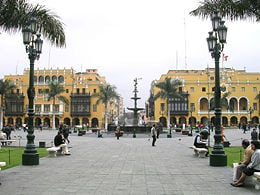
| |
| State Party | |
| Type | Cultural |
| Criteria | iv |
| Reference | 500 |
| Region** | Latin America and the Caribbean |
| Inscription history | |
| Inscription | 1988 (12th Session) |
| Extensions | 1991 |
| * Name as inscribed on World Heritage List. ** Region as classified by UNESCO. | |
The Historic Centre of Lima is the portion of the city of Lima, Peru, founded in 1535 by Spanish conquistador Francisco Pizarro as La Ciudad de los Reyes, or "The City of Kings."
Lima was designated the administrative capital and most important city in the Spanish Viceroyalty of Peru, established by Charles V in 1542. This viceroyalty became the richest and most powerful Spanish viceroyalty of The Americas, holding jurisdiction over all of the Spanish colonies in South America. By the time of the wars of independence (1820-1824), Lima had become one of the most distinguished and aristocratic colonial capitals and the chief Spanish stronghold in the Americas.
Today's South American culture reflects the complexity of the continent's history through the blending of pre-Hispanic civilizations and the culture of Spain, imparted during that country's centuries-long colonization of the New World. Language, music, and cuisine are intricate mixes of indigenous and Spanish elements. The Catholic religion brought by the missionaries is the dominant religion throughout the continent.
The Spanish settlement of Lima thus played a significant role in the shaping of modern-day Peru as well as much of South America. As such, the remaining buildings are historical treasures. Numerous of these buildings are the result of collaboration between Native and Old World craftsmen. Lima's historic center was declared a UNESCO World Heritage Site in 1988, for its originality and high concentration of historic monuments constructed in the time of Spanish presence. It is one of the most important tourist destinations in the region.
Foundation
The city of Lima, the capital of Peru, was founded by Francisco Pizarro on January 18, 1535 and given the name "City of the Kings." Nevertheless, with time its original name persisted, which may come from one of two sources: Either the Aymara language lima-limaq (meaning "yellow flower"), or the Spanish pronunciation of the Quechuan word rimaq (meaning "talker," and actually written and pronounced limaq in the nearby Quechua I languages). It is worth noting that the same Quechuan word is also the source of the name given to the river that feeds the city, the Rimac river (pronounced as in the politically dominant Quechua II languages, with an "r" instead of an "l"). Early maps of Peru show the two names displayed jointly.
The period of colonialism in South America was a time of magnificence and grandeur. Buildings were created as works of art.
A disastrous earthquake in 1656 destroyed many of the original structures in Lima. Reconstruction was begun the following year, much of it undertaken by Portuguese architect Constantino de Vasconsellos. His protégé, Lima-born Manuel de Escobar, later succeeded him in the task.
Balconies of Lima
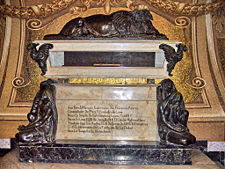
Lima is well-known for its balconies—more than 1,600—that were built in the viceroyalty era as well as during the republic. The abundance of these balconies adds to the particular harmony and originality in this part of the city.
The Municipality of Lima has adopted a system of "balcony adoption," giving both individuals and companies the opportunity to personally maintain an historic piece of the city.
Principal monuments
- Plaza Mayor
The Plaza Mayor (Plaza de Armas of Lima) is the birthplace of the city of Lima, as well as the core of the city. Located in the Historic Centre of Lima, it is surrounded by the Government Palace, Cathedral of Lima, Archbishop's Palace of Lima, the Municipal Palace, and the Club of the Union.
In 1523, King Charles I of Spain mandated the Procedures for the creation of cities in the New World. These procedures indicated that after outlining a city's plan, growth should follow a grid centered on the square shape of the plaza.
On the day of the foundation of the city, January 18, 1535, the conquistador Francisco Pizarro, conforming to established procedure, designated a location to build the plaza. Later, Pizarro and Nicolas de Rivera, the city's first mayor, toured the city's location and split parcels. Pizarro took for his residence a large parcel of land between the north side of the plaza and the Rimac river. The lot to the south of the plaza was designated to be a church, the western lot was to be the site of a city council, and the remaining lots were divided among the rest of the conquistadors.
The seventeenth century historian Bernabé Cobo said of the plaza:
…it is the finest and most well-formed [plaza] that I have ever seen, even in Spain. It occupies an entire block, with the width of four streets on one side and four streets on the other, and with all four sides it measures more than two thousand feet; it is very flat…
The first water fountain built on the plaza was constructed by the viceroy Francisco de Toledo, and was inaugurated on October 21, 1578. It consisted of a baluster and an elevated bowl, and contained eight pipes through which water fell into the bowl on the next level. A ball at the top of the fountain dispersed water back onto the lower levels. The seal of the city was inscribed on this ball.
This fountain was replaced by the viceroy García Sarmiento de Sotomayor, count of Salvatierra, who inaugurated the new one on September 8, 1651. This fountain remains as the centerpiece of the plaza.
During the colonial era, the plaza served as a market, bullfighting ring, and the city gallows. The plaza also became home to the Auto de fe in which the inquisition occurred. The tribunal of the inquisition had one of its three courts located in Lima. The first conviction occurred on November 15, 1573; the first so-called heretic to be tried and executed in the New World. In 1821, José de San Martín proclaimed the Independence of Peru on this plaza, after which the flag of the new republic was paraded around the plaza. The Plaza Mayor continues to be used for all historic events.
- Archbishop's Palace
The Archbishop's Palace is a structure that was opened in 1924, and is considered a prime example of neo-colonial architecture that flourished in Lima during the early twentieth century. It is located on land originally allocated by Pizarro as the residence of the head priest of Lima. The first church on this site began construction in 1535. Pope Paul III named Lima an episcopal seat in 1541 and designated the palace as the primary church headquarters of the city. In 1547, Lima was elevated to an archdiocese and the building served as its headquarters.
The palace was designed by the Polish-Peruvian architect Ricardo de Jaxa Malachowski, who used the Torre Tagle Palace as a reference point. The facade is composed of baroque elements, completely constructed of reintegrated rock; ornate cedar balconies are located over the main doors, and the palace is finished by a granite sculpture of Saint Turibius of Mongrovejo, the patron protector of the Archdiocese. The palace has two flagpoles, one for the Peruvian flag and another for the flag of the Vatican.
The interior, which hosts a sculpture of Santa Barbara, one of the Catholic Church's Fourteen Holy Helpers, is completely ornate. The ceiling contains famous French stained glass windows, illuminating the church during the daylight hours. Marble staircases with wooden handrails allow access to the second story. The palace now serves as headquarters to the offices of the cardinal of Peru and archbishop of Lima.
- Basilica Cathedral
The construction of the Basilica Cathedral of Lima, a well-known symbol of the city, began at the city's founding in 1535. Due to the earthquakes that frequently devastated the city, it has been transformed many times, but it still retains its colonial composition and facade. It is located beside the Archbishop's Palace.
The construction on the original building was completed in 1538. It was described as primitive, small and rustic. In 1541, the church was designated a cathedral. Additional structures were built and the building upgraded over the next several years. Throughout the remainder of the century the cathedral was redesigned and rebuilt on its original foundations, in an attempt to make it more closely resemble the Cathedral of Seville in Spain. In the following centuries, parts of the Cathedral were damaged or destroyed by earthquakes four times; the building was renovated after each occurrence.
The cathedral has three doors on its front facade, 14 side doors, and two back doors. Each is ornate and is named after a saint.
Along the interior walls are the Stations of the Cross (Via Crucis). The chapels are adorned with sculptures and images of numerous saints. The chapel Capilla de la Sagrada Familia (chapel of the Holy Family), features figures of Jesus, Mary, and Joseph.
- Government Palace
The Government Palace, also known as the House of Pizarro, is the residence of the President of Peru.
Pizarro built a modest two story dwelling for himself upon his arrival in Lima. The grounds were large to accommodate troops and horse stables. Upon Pizarro's death, Spanish viceroys took over the building, converted it into a Viceregal Palace and continually enlarged the building over time.
It served as the residence of viceroys until they were forced out in 1821. Since that time it has served as the headquarters of the Presidents of the Republic of Peru. In 1921, fire destroyed a great deal of the building. Reconstruction was completed in 1938.
There is a well-kept garden on the grounds and a number of courtyards, halls and rooms dedicated to notable figures of Peruvian history.
- Torre Tagle Palace
The Torre Tagle Palace is a Spanish Baroque palace that serves as home to the Peruvian Ministry of Foreign Affairs.
The palace was commissioned in 1715 (some say 1730) by Don José Tagle and Brachio (Marquis Torre Tagle), who at the time was treasurer of the Royal Spanish fleet, for his own personal use as his home.
The exterior of the palace has a baroque stone doorway. The main facade is made from stone in the first wing and plaster in the second. The style is Sevillian baroque with a strong Mudejar influence. The materials used in its construction were brought from Spain, Panama, and Central America.
Apart from carved columns, the palace is distinguished by two finely worked balconies in dark wood. These balconies adapt the European architecture to vernacular Peruvian tradition. The interiors feature Sevillian tiles, plasterwork, wooden columns, lobed Moorish arches and soaring coffered ceilings. It is considered to have a true "Limeño" architectural originality, harmoniously combining Andalusian, Moorish, Criollo, and Asian features.
- Basilica of Our Lady of the Rosary and Convent of Santo Domingo
Construction of the church and convent began at the founding of Lima and was not completed until the end of the sixteenth century. It is composed of three naves with a carved choral ashlar masonry in cedar wood. The church is crowned by a large cupola. The interior displays images from the first years of the City and also an image of Our Lady the Virgin of the Rosary.
The convent has Sevillian style patios in tile, with baroque style in the interior. It was here, in 1551, that the National University of San Marcos was founded, the first in the Americas.
The temple of Our Lady of the Rosary (original name of the church of Santo Domingo) was elevated to the category of basilica in 1930, and in its interior is the Altar of the Peruvian Saints, which is visited annually by thousands of residents of Peru and by many foreigners.
- Basilica and Convent of San Francisco
Convento de San Francisco is the Spanish name for Saint Francis Monastery. The building is noted for its seventeenth century architecture, a high example of Spanish Neoclassicism. The complex contains a convent, a church, and the chapels of the Solitude and the Miracle. The cloisters and the world renowned library are adorned with Sevillian tiles. There is a network of underground galleries and catacombs, which are said to connect to other catacombs beneath the cathedral and other area churches. The church was completed in 1674.
- Merced Church
The Church of Merced was constructed in eighteenth century with a churrigueresco style. The church contains numerous works of art, with an emphasis on the greater altar in honor to the Virgin of Mercedes and one sacristy with arabesque tiles. The Virgin of the Mercedes is the patron of the Arms of the Nation.
- Sanctuary and Monastery of Las Nazarenas
The Sanctuary and Monastery of Las Nazarenas was built in the eighteenth century, after the disastrous earthquake of 1746. The sanctuary holds the mural known as The Lord of Miracles (Jesus Christ), patron of the city.
The main Catholic festival in Peru is held here in conjunction with one of the largest processions. Every October hundreds of thousands of faithful from all races and economic backgrounds celebrate The Lord of Miracles in a religious procession through the streets of Lima. The boulevards are dressed in purple to honor the Lord on his annual procession through the city's streets.
- Basilica of San Pedro
The main church of Society of Jesus in Peru, the building was constructed in 1638 as Church of San Pablo Apóstol. In 1767 it was renamed San Pedro.
- Plaza San Martin
This plaza was inaugurated in 1921, on the occasion of the centenary of the Independence of Peru. A monument in honor of general José de San Martín is the centerpiece of the Plaza. It was built by the Catalán sculptor Mariano Benlluire. Surrounding this plaza are the Bolivar Hotel, which was long considered the most elegant hotel in Lima, as well as the Club Nacional, patronized by the city's high society.
- Court of Santo Oficio
The Court of Santo Oficio was established in 1569 with the purpose of sanctioning heresies and other crimes against the Catholic faith. Its abolition dates from 1820. On the external part of this monument it is possible to see an imposing neoclassic porch and, in the main hall, an outstanding carved wood ceiling, which is considered the best in the city.
- House of Aliaga
This building was constructed in 1535 on the location of what was believed to be a site sacred to the indigenous peoples. Originally built for Jerónimo de Aliaga, standard-bearer for Francisco Pizarro, it has served as residence for his descendants since that time. It is Lima's oldest mansion, next to the Government Palace. Built in the opulent style of the viceroyalty era, and in a near perfect state of conservation, it is often used for special cultural events.
- House of Oidor
One of the oldest homes of the city belonged to the Oidor, a special administrative representative appointed by the Spanish monarchy to act in the colonial administration. The Oidor traversed the territory and served as a consultant to the viceroy.
- House of Pilatos
Constructed in 1590 by a Jesuit priest. The name of this large house was given by the Spaniards who arrived and noted the similarity of the house with one in Seville.
- Goyeneche House
This is one of the most outstanding houses of the historical center, constructed in the middle of the eighteenth century with French influence. It is preserved in its original state with its balconies reflecting a typical characteristic of colonial Lima.
- Riva Agüero House
This house was constructed in the eighteenth century by the Riva Agüero family, whose last member, Jose of the Riva Agüero, donated it to the Pontifical Catholic University of Peru. It is used as headquarters of the Riva Institute, conserving historical files and a library being simultaneously used by the local Museum of Popular Art of the Pontifical University.
ReferencesISBN links support NWE through referral fees
- Andrien, Kenneth. 1985. Crisis and Decline: The Viceroyalty of Peru in the Seventeenth Century. Albuquerque: University of New Mexico Press. ISBN 0826307914.
- Comercializadora Electrónica de Turismo. Historical Center of Lima. Retrieved October 16, 2008.
- Higgings, James. 2005. Lima. A Cultural History. Oxford: Oxford University Press. ISBN 0195178912.
- Hunefeldt, Christine. 2004. A Brief History of Peru. New York: Checkmark Books. ISBN 081605794X.
- Walker, Charles. "The upper classes and their upper stories: architecture and the aftermath of the Lima earthquake of 1746." Hispanic American Historical Review 83 (1): 53–82.
| |||||||
Credits
New World Encyclopedia writers and editors rewrote and completed the Wikipedia article in accordance with New World Encyclopedia standards. This article abides by terms of the Creative Commons CC-by-sa 3.0 License (CC-by-sa), which may be used and disseminated with proper attribution. Credit is due under the terms of this license that can reference both the New World Encyclopedia contributors and the selfless volunteer contributors of the Wikimedia Foundation. To cite this article click here for a list of acceptable citing formats.The history of earlier contributions by wikipedians is accessible to researchers here:
- Historic_Centre_of_Lima history
- Archbishop's_Palace_of_Lima history
- Cathedral_of_Lima history
- Torre_Tagle_Palace history
- Plaza_Mayor_of_Lima history
The history of this article since it was imported to New World Encyclopedia:
Note: Some restrictions may apply to use of individual images which are separately licensed.
